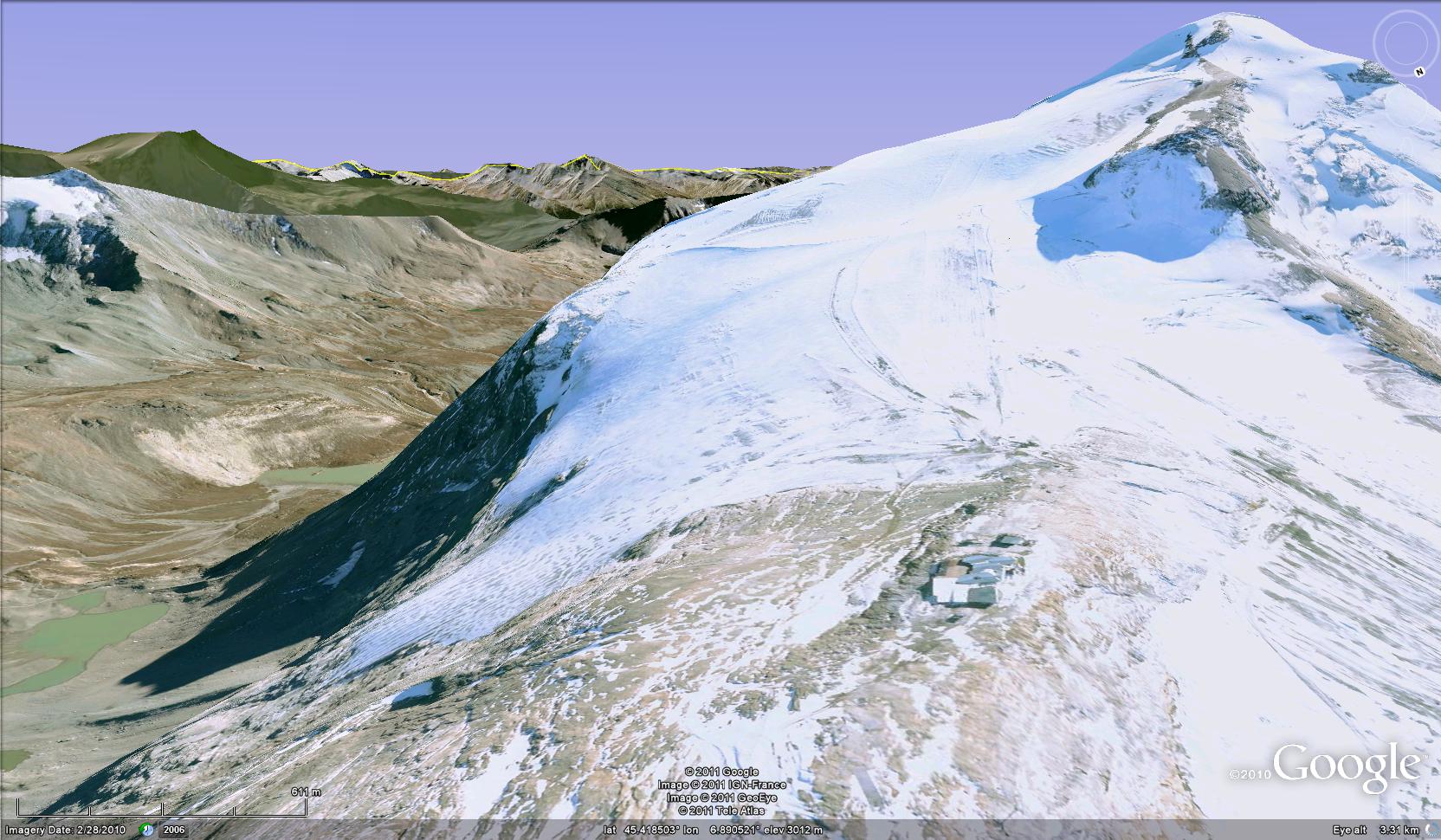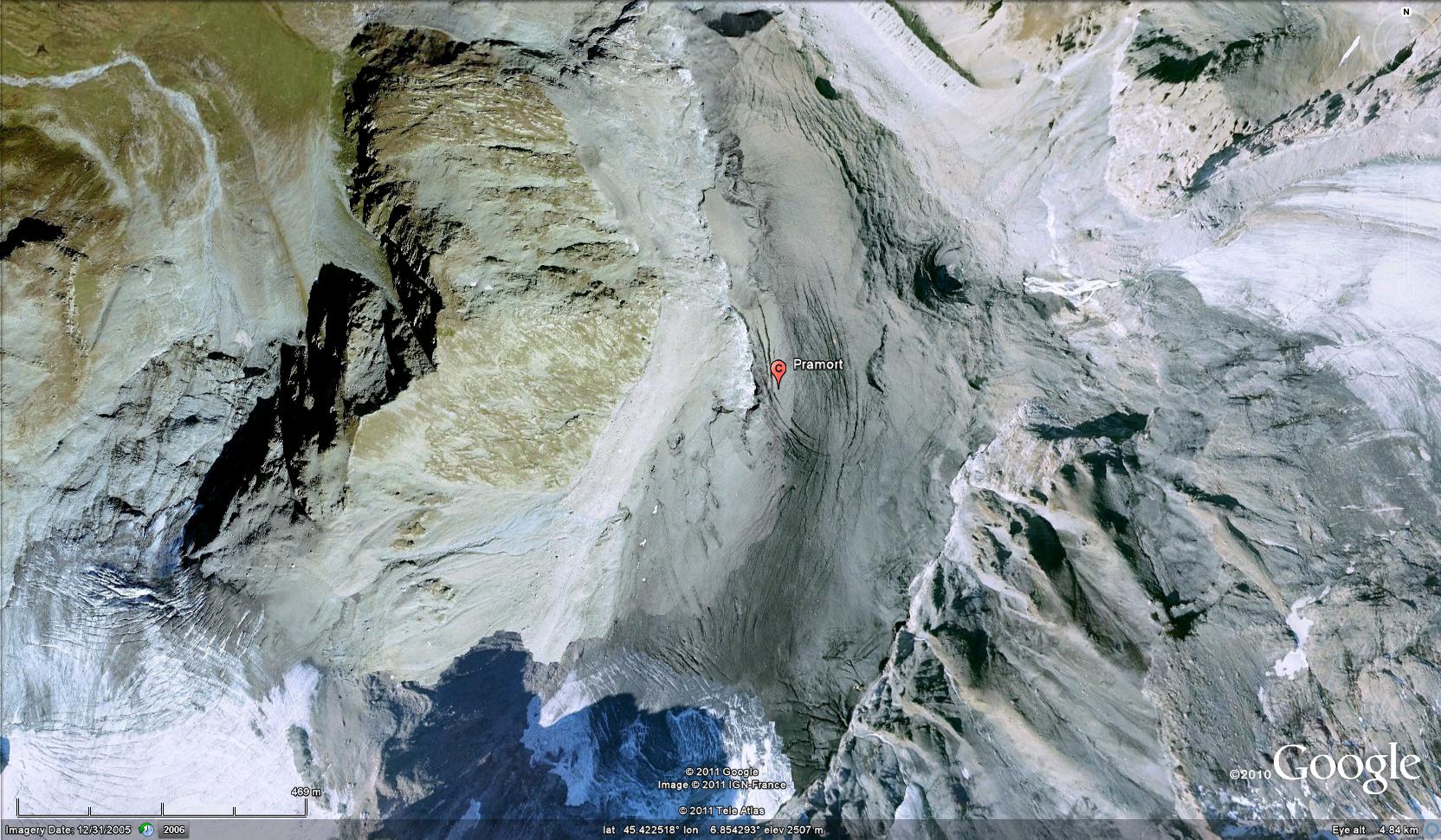August 20, 2011
Grande Motte, Pramort Glacier Retreat and the Tignes Ski area, France
Posted by Mauri Pelto
The Tignes ski area in France is famous for its great summer glacier skiing. The portion of the area that is generally open from early June to early September is on the Grand Motte Glacier
 . A webcam view for the glacier indicates that on Aug. 20th there is limited snowcover on the glacier, note the 3100 meter camera view, and the ski season will likely be cut short a bit. The bottom of the lift is at 3000 meters and the top of the lift is at 3450 meters. This webcam even has the ability to look back at archive coverage. To protect the ski season on the Grand Motte Glacier the resort has adopted the use of snow guns at the bottom of the Grande Motte Glacier lift. This is similar to the strategy on Pitzal Glacier. A look at the Grande Motte Glacier (Point A) and two neighboring glaciers indicates the issue.
. A webcam view for the glacier indicates that on Aug. 20th there is limited snowcover on the glacier, note the 3100 meter camera view, and the ski season will likely be cut short a bit. The bottom of the lift is at 3000 meters and the top of the lift is at 3450 meters. This webcam even has the ability to look back at archive coverage. To protect the ski season on the Grand Motte Glacier the resort has adopted the use of snow guns at the bottom of the Grande Motte Glacier lift. This is similar to the strategy on Pitzal Glacier. A look at the Grande Motte Glacier (Point A) and two neighboring glaciers indicates the issue.  The terminus of Grande Motte Glacier at 2700 meters, top image, is thin and uncrevassed, indicating retreat will continue. In 2011 as in most years the majority of the glacier has lost its snowcover. This indicates a negative mass balance and continued glacier loss. The neighboring Pramecou Glacier, labelled B, is completely bare of snow in the Google Earth imagery, is quite thin and uncrevassed. This glacier has separated into three parts, the largest is labelled and is still 500 meters wide and 400 meters long, it will still melt away in the coming decade. The Parmort Glacier, Point C, used to be connected to the Grande Motte Glacier and the Pramecou Glacier. It is now a 1 km long debris covered stagnant terminus tongue ranging from 2700 meters to 2400 meters. This glacier has no snowcover at the end of most summer and is melting away. There are several areas of concentric crevasses that indicate basins beneath the glacier that periodicially fill with water lifting the glacier a bit, then drain, leading to the crevasses.
The terminus of Grande Motte Glacier at 2700 meters, top image, is thin and uncrevassed, indicating retreat will continue. In 2011 as in most years the majority of the glacier has lost its snowcover. This indicates a negative mass balance and continued glacier loss. The neighboring Pramecou Glacier, labelled B, is completely bare of snow in the Google Earth imagery, is quite thin and uncrevassed. This glacier has separated into three parts, the largest is labelled and is still 500 meters wide and 400 meters long, it will still melt away in the coming decade. The Parmort Glacier, Point C, used to be connected to the Grande Motte Glacier and the Pramecou Glacier. It is now a 1 km long debris covered stagnant terminus tongue ranging from 2700 meters to 2400 meters. This glacier has no snowcover at the end of most summer and is melting away. There are several areas of concentric crevasses that indicate basins beneath the glacier that periodicially fill with water lifting the glacier a bit, then drain, leading to the crevasses. 

 The glaciated landscape in this area is changing dramatically (Gardent and Deline, 2011) noted a 30% loss in glacier area since the 1960’s. This trend is following the behavior of Glacier D’Argentiere and Mer De Glace. Those larger glaciers are not currently threatened, as these are with melting away.
The glaciated landscape in this area is changing dramatically (Gardent and Deline, 2011) noted a 30% loss in glacier area since the 1960’s. This trend is following the behavior of Glacier D’Argentiere and Mer De Glace. Those larger glaciers are not currently threatened, as these are with melting away.


 Dean of Academic Affairs at Nichols College and Professor of Environmental Science at Nichols College in Massachusetts since 1989. Glaciologist directing the North Cascade Glacier Climate Project since 1984. This project monitors the mass balance and behavior of more glaciers than any other in North America.
Dean of Academic Affairs at Nichols College and Professor of Environmental Science at Nichols College in Massachusetts since 1989. Glaciologist directing the North Cascade Glacier Climate Project since 1984. This project monitors the mass balance and behavior of more glaciers than any other in North America.